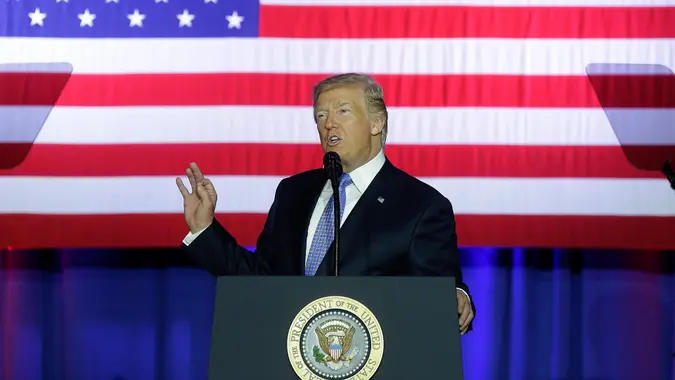What Is the IRS Fresh Start Program and How Does It Work?

Commitment to Our Readers
GOBankingRates' editorial team is committed to bringing you unbiased reviews and information. We use data-driven methodologies to evaluate financial products and services - our reviews and ratings are not influenced by advertisers. You can read more about our editorial guidelines and our products and services review methodology.

20 Years
Helping You Live Richer

Reviewed
by Experts

Trusted by
Millions of Readers
Many Americans have found themselves in dire straights of financial hardship. Paying bills is already difficult before you factor in your taxes. No matter your financial situation or the state of your tax returns, it is always good to know where you can get a little bit of help.
What Is the IRS Fresh Start Program?
In 2011, the IRS announced the Fresh Start program. The IRS Fresh Start tax program is a set of initiatives designed to help taxpayers, including individuals and small businesses, who are having problems and cannot pay their taxes.
These IRS Fresh Start initiatives are for those who cannot pay the full amount they owe but can pay in installments. It is also intended for taxpayers who owe less than $50,000 in taxes. Specifically, the program is designed for taxpayers who would face a worse financial situation after incurring significant tax penalties. While the program usually doesn’t relieve your tax debt, it does make it easier for you to get caught up on your owed taxes.
The program works by giving taxpayers additional tax repayment options. When you’re trying to pay off your tax debt without help, you may face tax penalties and fees that increase the amount that you owe, making it difficult to get up.
IRS Fresh Start Tax Relief Program Eligibility
The IRS Fresh Start program has no income requirements. However, you must meet several other eligibility requirements. To qualify:
- You must have filed all of your required tax returns for the past three years.
- You cannot owe more than $50,000 in taxes or have been involved in any tax evasion or fraud.
- You must have made all of your required estimated tax payments in the previous year.
In addition to these eligibility requirements, certain Fresh Start initiatives have additional requirements. For example, to qualify for an offer in compromise, you can’t be involved in an open bankruptcy proceeding, and must have a valid extension for a current year’s tax return.
To determine if you are eligible you may have to visit the IRS website, call or email an IRS representative or visit your local tax office.
IRS Fresh Start Pros and Cons
| Pros | Cons |
|---|---|
| Reduces penalties and interest on the penalty | Every payment option has its own set of qualifications for eligibility. |
| Can prevent tax lien being filed against you the taxpayer | You may have to work with a tax relief company or other tax professionals to make sure you don’t pay more than you owe. |
| Requires no disclosure of income or assets to the IRS | You cannot be associated with any tax fraud or evasion activities. |
4 Main Fresh Start Initiatives and Payment Options
Essentially the IRS Fresh Start Program can be broken down into four main initiatives. The payment options include
- Offer in Compromise
- Installment agreement
- Penalty abatement
- Currently Not Collectible status
1. Offer In Compromise
Offer in Compromise, or OIC, is when you are eligible to settle for a reduced amount rather than having to pay the full amount you owe. Here are some key takeaways from OICs:
- You are not currently involved in a bankruptcy case.
- You’ve made all estimated payments on your filed tax returns.
- You have an approved extension for your current tax year return.
- If you are self-employed, you’ll need to verify you’ve made your last two deposits, in addition to your current one.
2. Installment Agreement
If you qualify for this option, as the name would suggest, you would be allowed to break your payments into reasonably more affordable monthly payments. These payments would continue to the IRS until the debt was paid in full. You should note that once the debt dips beneath $25,000, previously existing tax liens and levies will be removed.
3. Penalty Abatement
For this method, you will need to prove to the IRS that the reason you haven’t paid your tax bill is both reasonable and worthy of penalty relief. If they accept the reason you’ve provided, you may have your penalties forgiven. This can make paying down your tax debt a much more achievable goal.
4. Currently Not Collectible Status
Unlike the other three payment options, this option is not a method but a status. This status allows payments to be put on hold during times of severe financial hardship. Features of the Currently Not Collectible status include:
- Eligibility depends on your ability to show that paying both living expenses and back taxes will cause more financial hardship.
- It does not forgive tax debt but delays payment until you are more financially stable.
How to Apply for the IRS Fresh Start Program
To apply for the IRS Fresh Start program, you will need to fill out an application for the initiative of your choice. The IRS website includes links to the applications for each initiative. Since requirements for each initiative vary, be sure to pay close attention to the eligibility requirements and the documents requested for each application.
For example, if you apply for a payment plan, you will need to create an ID.me account and will need photo identification. For a direct debit plan, you will need your bank routing and account numbers. You may also need to provide the balance due shown on your recent tax return.
While you can apply for the program yourself, the applications can be confusing. If you’re uncertain of how to correctly complete the applications, you can consult a tax resolution service or tax professional to help guide you through the process.
Once your application is approved, you will need to follow the plan specifications precisely. If you miss payments or violate the plan terms, you could be dismissed from the program. In addition to paying down your taxes owed, you will also be responsible for filing all future returns and paying those taxes.
IRS Fresh Start Program vs. Other Tax Relief Options
The IRS Fresh Start program features several initiatives, so you can choose the option that best works for your situations. If you’re approved for the program, the IRS will tailor a solution to your specific tax debt, and these solutions can help you pay back your owed taxes without incurring hefty fees and penalties that slow or make repayment impossible.
Credit Cards
Other tax relief options exist, too. You could use a credit card to pay off your taxes, avoiding fees and penalties. However, you could face significant interest while you work to pay off your credit card balance. A credit card with an introductory 0% interest period would give you more time to pay off the balance, but these cards can be difficult to quality for.
Personal Loan
Some taxpayers choose to take out a personal loan, since it can be easier to qualify for a personal loan than for a 0% APR credit card. Keep in mind that personal loans can still have high interest rates, especially if you don’t have excellent credit.
Tax Relief Companies
Tax relief companies are another potential solution. These companies work with the IRS to reduce or eliminate your debt, and they can help arrange installment payment plans to make paying back your debt more manageable. Most companies charge an initial fee to investigate your debt and identify potential solutions, and they may also require you to have a minimum amount of tax debt.
While there are many potential ways to pay down your taxes, you will need to carefully consider your options and decide which route is right for your financial situation.
Final Take To GO
If the idea of approaching the IRS by yourself is overwhelming, many tax relief services can help you through these taxing times. Here are some top companies to consider:
- Tax Relief Advocates
- Anthem Tax Services
- Community Tax
- Fortress Tax Relief
- Larson Tax Relief
- Precision Tax Relief
- Tax Defense Network
FAQ
Here are the answers to some of the most frequently asked questions about the IRS Fresh Start Tax Relief Program.- Who qualifies for the IRS Fresh Start Program?
- To qualify for the IRS Fresh Start Program here are some possible requirements:
- If you are self-employed, you have dropped in income by at least 25%.
- You don't owe more than $50,000 in taxes, including penalties and interest.
- You must be able to pay your outstanding tax obligations within six years.
- To qualify for the IRS Fresh Start Program here are some possible requirements:
- What is the IRS fresh start program for 2024?
- The IRS Fresh Start Tax Relief Program is a set of initiatives that gives aid to struggling taxpayers to help reduce their tax debt. This is through the implementation of tax relief procedures such as the following:
- Debt settlement
- Payment plans
- First-time penalty waivers
- A temporary delay in tax collections
- The IRS Fresh Start Tax Relief Program is a set of initiatives that gives aid to struggling taxpayers to help reduce their tax debt. This is through the implementation of tax relief procedures such as the following:
- How much is the IRS Fresh Start Program?
- Unfortunately, depending on the IRS Fresh Start initiative there can be setup and application fees. For example, the Offer-in-Compromise may charge up to a $205 application fee.
- Is there really an IRS tax forgiveness program?
- Yes, the IRS Fresh Start tax relief program offers several initiatives to aid you in paying your tax debts including:
- Offer in Compromise
- Installment agreement
- Penalty abatement
- Currently Not Collectible status
- Yes, the IRS Fresh Start tax relief program offers several initiatives to aid you in paying your tax debts including:
- How does the IRS Fresh Start program impact your credit score?
- Since credit reports don't track unpaid taxes, your tax debt won't directly impact your credit score. However, tax penalties and fees can make it difficult to keep up with other debts owed, and late payments on other accounts, like your mortgage or car loan, could negatively impact your score. By helping you pay off your tax debt, the Fresh Start program could help protect your credit score from negative impacts.
Paige Cerulli contributed to the reporting of this article.
Our in-house research team and on-site financial experts work together to create content that’s accurate, impartial, and up to date. We fact-check every single statistic, quote and fact using trusted primary resources to make sure the information we provide is correct. You can learn more about GOBankingRates’ processes and standards in our editorial policy.
- IRS. "Offer in Compromise."
- Tax Law Advocates. "The IRS Fresh Start Program: FAQs & Qualifications."
- IdealTax. 2023. "The IRS Fresh Start Program: 2023 Updates."
 Written by
Written by  Edited by
Edited by 
























